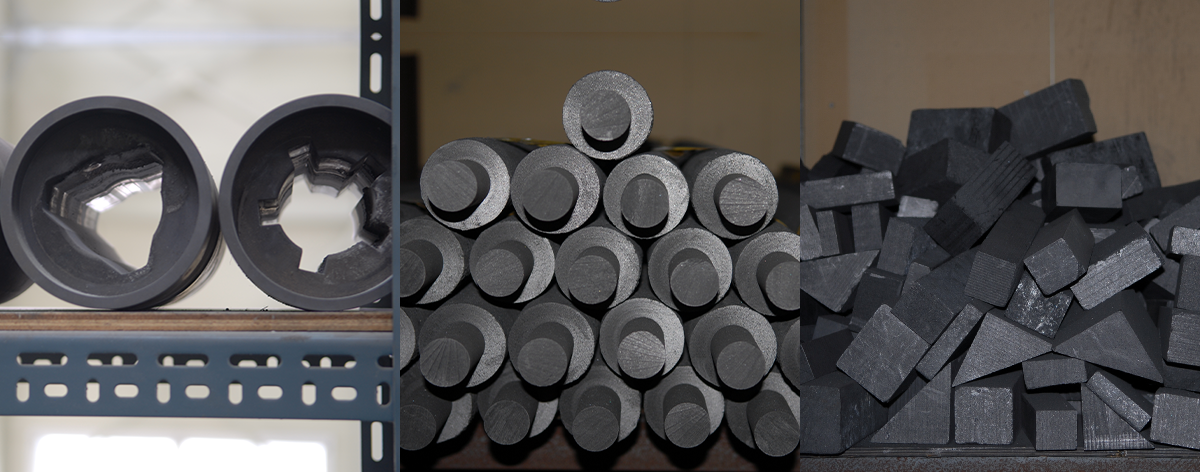
Product Information
Carbon/Graphite

CARBON FIBER
The term carbon fiber here is used to refer to CFRP (carbon fiber reinforced polymer or plastic) made of carbon fiber.
CFRP is lighter and is better in terms of tensile strength and elasticity than metals. It is noteworthy that its compression strength and impulse strength is worse than metallic materials.
Thus, it is wrong to think that CFRP is the strongest material regardless of use. In addition, that the elastic constant of a material is high is often taken as meaning that the material easily bends, but the engineering expression actually means that it doesn’t bend easily. The density of such CFRP is 1.5~1.6g/㎠ at the fiber volume ratio of 60%, which indicates that it is very light, and CERP has an impressively excellent tensile strength and elastic constant compared to special steel. Some regard its property of matter as superior to ultra-high tensile steel, but this is the case of pure fiber not the case of molded CFRP. However, as for iron, its density is more than 7.8g/㎠, thus CFRP is much higher in specific strength. Therefore, it is used for vehicles like cars and bicycles which require light weight and strength, and it is especially used in expensive products such as super cars, space shuttles and planes due to the matter of expense.
The cost of materials of carbon fibers is not that expensive. However, the price of molded products becomes far more expensive than the cost of the materials due to the labor-intensive process which is a characteristic of the process of composite materials, especially that of high-strength composite materials which are supposed to have a high proportion of fiber. Today, although studies on automated laminating are being actively conducted, and performance quality is being improved, high-strength molded products which have free shapes are still produced manually.
GRAPHITE
- Raw material
- - Petroleum coke derived from crude oil, the atomic number of which is 12, and Pitch coke derived from coal are used as the main raw materials, and Coal tar pitch and phenolic resin are used as binders when molding. After that, it should be baked at the temperature of about 1000°C ~1300°C to get carbon. The temperature can be reduced to about 350°C under oxidizing conditions.
- Manufacturing
- - As a result of carbonization of the raw materials mentioned above that takes place in a kiln at the temperature of 1000~1300°C, carbon is obtained, and again the non-crystalline carbon becomes the graphite which has crystal structures when the carbon is baked in an electric resistance furnace at the temperature of 2500 ~ 3000°C.
- - Before the carbon gets graphitized, it can go through pitch impregnation when necessary to improve its mechanical and electrical properties, then goes through baking again. (Strength, conductivity, resistance to oxidation)
- Characteristics
- - When carbon is baked in a reducing atmosphere for about 2 weeks at a high temperature (about 2,500~3,000°C), it becomes graphite which has a stable hexagonal structure.
- - The temperature can be reduced to about 600°C under oxidizing conditions, and increased up to about 3,000°C in a reducing atmosphere.
- Lubricity of graphite
- As minute amounts of graphite interacts with counterparts, a thin graphite membrane is formed and sticks to surfaces, and the membrane reduces friction between the two surfaces preventing the surface of a machine from wearing. The lubricity of graphite is useful not only in non-lubricating liquids like water or organic solvents, but also in dry conditions.
- Thermal characteristics of graphite
- Graphite doesn’t melt at temperature below 3000℃. Graphite has excellent heat conductivity in contrast to most non-metallic components or compounds. This characteristic makes graphite more useful for electrical mechanical and structural uses, metallurgic purposes especially including manufacturing molds and dies and selecting materials for them.
- Thermal expansibility
- The range of thermal expansion of graphite is narrow, thus graphite serves to offer stability (precision) in measurement (volume) of parts that are sensitive to temperature change.
- Chemical characteristics
- Graphite is unstable at room temperature (inactive), but reacts with air at high temperature, and generally reacts with oxygen at a temperature of not less than 400℃.
CHARACTERISTICS OF GRAPHITE
- Graphite can be produced in the highest purity.
- Wettability – Graphite doesn’t get wet from most melted metals.
- Temperature resistance – Graphite sublimes at a very high temperature (about 3350℃).
- Resistance to temperature change – Graphite has an excellence resistance to thermal shock, so frequent heating and cooling is not a problem.
- Mechanability – Graphite is easy to process, and the edges have a high strength and abrasion resistance. It can be precisely processed where complicated structures and minute differences are involved.
- Thermal conductivity – Thermal conductivity of graphite is higher than that of many other metals and decreases as the temperature increases. Thermal conductivity varies depending on the type of graphite.

